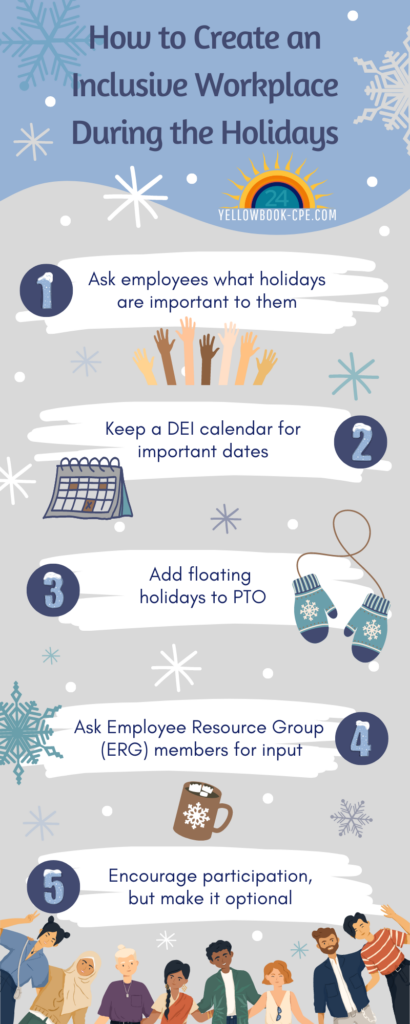Special thanks to Lisa M. Ong, CPA PCC, President and Founder of Wishing Out Loud LLC, for granting permission to share this valuable article on how to create an inclusive workplace during the holidays.
How to Create an Inclusive Workplace During the Holidays
Holidays are important to many people. They hold traditions, emotions and cultural significance. In workplaces, it’s important to be mindful of all holidays. Celebrating them in a meaningful and inclusive way for all employees creates cultural learning opportunities.
Here are five ways to create an inclusive workplace during the holiday season.
1. Ask employees what holidays are important to them
Some organizations might not know exactly where to start or what holidays are important to their workforce. The easiest way is to ask. By sending a short survey at the beginning of the year, organizations can better understand which holidays matter and what they want to celebrate.
Create opportunities to educate your workforce about other cultures by coordinating events with explanations around the cultural significance while creating opportunities for engagement. It fosters a sense of belonging when someone is greeted with well-wishes for their favorite holidays such as Happy Diwali, Happy Mid-Autumn Moon or “thinking of you as you celebrate the life of your loved ones” (Day of the Dead), etc.
It shows even more awareness to know the holiday meanings and observances so your messages are sent at the appropriate times. For example, many Orthodox Jews avoid using technology during Yom Kippur. On this holiday, wishing a close colleague a meaningful fast before sundown may be appreciated as they use this time for quiet self-reflection. Even when I have researched the observance, I found politely asking how I can support their observance and preference to be greeted shows my sincere interest in learning and being inclusive.
2. Keep a DEI calendar for important dates
Once a company is aware of the workforce’s favorite holidays, it should keep a calendar of all events. This way, it is easy to revisit the list and make plans in advance. During planning, it’s important to know the employees’ backgrounds as well. For example, avoid scheduling an all-hands meeting during the Jewish High Holy Days or a party on a day when some employees may be fasting. Also, use the list for highlighting diverse employees and vendors in the company newsletter or on your social channels.
3. Add floating holidays to PTO
The current federal holidays were formed, in some cases, decades ago. The current calendar lacks the premise that companies are international and include people of all ethnicities, cultures and beliefs. Organizations should continue to update their list of holidays to reflect the demographics of their workforce or offer an option inclusive for everyone.
It’s hard to allow time off for every holiday for every person. Adding floating holidays is a great way to give employees flexibility in their time off. By creating paid holidays, employees can observe and celebrate without the fear of work interfering.
4. Ask ERG members for input
In the past, many companies with good intentions have had holiday celebrations go awry. Ask for volunteers or members of the Employee Resource Groups (ERGs) for input when planning celebrations most meaningful to them to share with their colleagues. Empower them with time, budget and recognition for their contributions.
ERG participants can enhance company culture and find new ways to improve internal communication. They have a better pulse on what is happening in the local community, what authentic vendors to select or what might be well-received by their peers. Diverse leadership in the planning process with various perspectives is the best way to create a memorable, authentic and educational celebration.
5. Encourage participation, but make it optional
Although you may enjoy the holidays, the reality is that it’s not a happy time for all. During the holiday season, it’s respectful to include everyone but leave space for employees to opt-out. For example, don’t make a potluck or a gift exchange mandatory. Create a sign-up sheet and allow everyone to participate freely. The goal is not to create mandatory situations leaving employees feeling secluded.
Holidays can be a great time to deepen work relationships. To create that bond, employees must feel included and heard. Remember it’s important to Listen. Learn. Then Lead With TLC (Transparency, Leadership by Example and Caring)™. Then the ROI (Relationships, Outcomes and Impact) of DEI™ will be well worth it.
Want to learn more about DEI+B?
Join Lisa M. Ong, CPA PCC on March 4 for a 2-hour live CPE webinar called Five DEI + Belonging Strategies for All Government Auditors. In this session, Lisa will share five personal strategies individual leaders can use with their audit teams to be the change they wish to see. No matter where you or your team are on the DEIB journey, you will find practical ideas and free resources to implement immediately.


 Yellowbook-CPE.com is registered with the National Association of State Boards of Accountancy (NASBA) as a sponsor of continuing professional education on the National Registry of CPE Sponsors. State boards of accountancy have final authority on the acceptance of individual courses for CPE credit. Complaints regarding registered sponsors may be submitted to the National Registry of CPE Sponsors through its website:
Yellowbook-CPE.com is registered with the National Association of State Boards of Accountancy (NASBA) as a sponsor of continuing professional education on the National Registry of CPE Sponsors. State boards of accountancy have final authority on the acceptance of individual courses for CPE credit. Complaints regarding registered sponsors may be submitted to the National Registry of CPE Sponsors through its website: